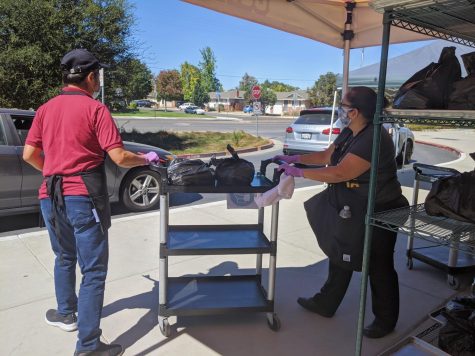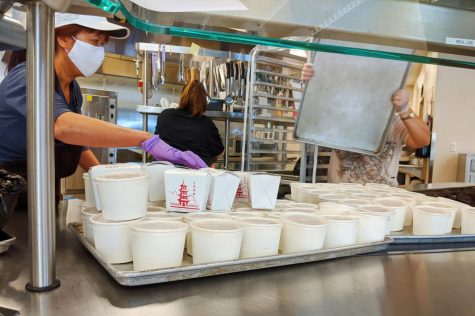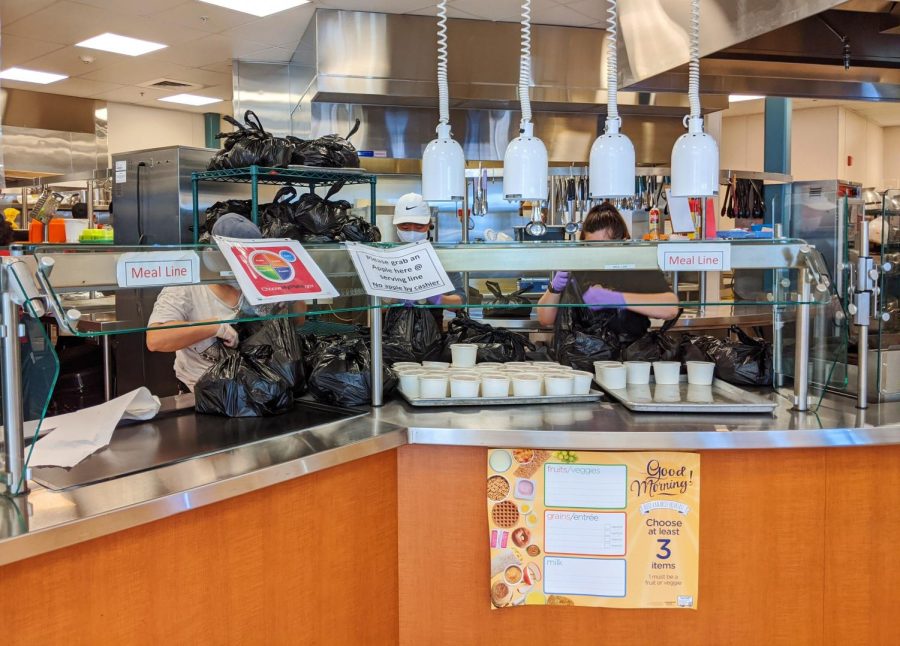FUHSD extends free meal service to anyone under age 18, no questions asked
Workers bag meals at the Cupertino High School cafeteria.
October 7, 2020
Through remote learning, FUHSD has been offering free meal pick ups every Wednesday for any individuals under 18 at Cupertino, Homestead and Fremont High School since Sept. 2. Six days of meals are given at a time, and no student identification is required.
Parents or children can pick up meals from 11 a.m. to 1 p.m. Unlike similar programs during the summer, a student ID is no longer required as children not in FUHSD are now also allowed to pick up meals. This policy was implemented in August 2020 after the FUHSD Food Services Department wrote letters to the United States Department of Agriculture (USDA) voicing how providing meals exclusively for the district’s students was not meeting the needs of the community.
The district gained approval from USDA on Aug. 31 to feed anyone under the age of 18, and they began doing so on Wednesday, Sept. 2.
When remote learning began in March 2020, students paid for meals according to the meal plan they had during in-person school. Now, meals are free regardless of eligibility for a free or reduced meal plan.
During a normal school year, FUHSD would not qualify for Seamless Summer Option (SSO), a program that allows schools to serve free meals to persons under age 18 in areas where more than half of students are on free or reduced lunch programs. However, because of the pandemic, the district received a waiver from the USDA presented by the California Department of Education that allowed any district to participate in SSO if the district thought it would benefit the community.
FUHSD decided that participating in SSO would be the right choice because it gives families one less item to worry about during a time when jobs and finances are so uncertain.
“If a family has two or three kids, the parents were supposed to go to an elementary school to pick up meals for one child then go to a high school [to pick up meals for the other child],” FUHSD Food Services Manager Divya Puri said. “In the end, parents are busy, everybody’s working and it’s just too much to take care of during distance learning.”
Pickup sites are currently located at Cupertino, Homestead and Fremont High Schools. Lynbrook and Monta Vista High School sites were closed in the spring after an initial effort to offer meal pickup sites at all schools in the district due to low participation. The district’s food workers are split between the three sites, and staff are moved accordingly to support the sites that experience higher demand.
“Of course you miss your colleagues, but then you get used to it because the work is the same,” said Food Service Assistant Anna Conroy, who worked at Lynbrook during in-person learning but was moved to Cupertino then Homestead after the Lynbrook site closed. “You make friends with the other ladies.”
The FUHSD Food Services Department was able to provide meal pickups smoothly at the start of this school year because the current drive-through pickup process was developed at the beginning of distance learning.

At each site, a student or parent tells a worker how many meals they would like with a show of hands. Then, a worker places the necessary amount of meals on a “social distancing table,” a small cart with wheels, and rolls it over to the curb instead of handing the bag of meals directly to the recipient. The staff walk back while the parent or student picks up the meal, and the table is sanitized after every pickup.
To further ensure the safety of everyone involved and decrease the chance of any staff contracting coronavirus, staff also wear masks, maintain social distancing and go through temperature checks and a self-screening every morning. Face shields are set to be implemented in the near future.
“I do feel safe working during the pandemic because we always keep our six-feet distance,” said Conroy.
Staff now only work for three days a week. On Mondays and Tuesdays, they check the inventory, make sure all needed products are supplied or work on production by packaging certain foods to prepare for delivery on Wednesday.
The amount of meals staff prepare is based on data from previous weeks. At Fremont High School, around 3000 meals are prepared each week.
“[If we have] leftover [meals], we have to toss them because we can’t keep them for a week,” Fremont High School Food Service Manager Paula Lopez said. “And if we run out [of meals] and more parents are coming through, we have staff inside that can prepare frozen and individually-wrapped items right away.”

The food for each week is the same across all three pickup sites. The menus, which can be found on the district’s website, are similar to what was available during in-person learning, but the process of preparing the meals has changed drastically. Workers spend more time individually preparing, bagging and counting meals than performing service duties or preparing food for display.
Normally, menu items like muffins would be freshly baked and displayed in the open, but now, they are frozen and individually packaged to prevent cross-contamination. If the district’s beloved breakfast burritos are scheduled to be eaten on the third, fourth or fifth days of the week, they no longer can be made on the spot. Instead, they must be purchased from a vendor that offers frozen options.
“We don’t offer something that’s cooked and hot for the fifth day because of food safety and decreased food appeal after students or parents store it and reheat it,” Puri said.
Gold Star Foods is the main supplier for the district, but other vendors also bid to supply frozen foods. Purchasing from vendors also helps workers keep up with the increased demand brought on by feeding students outside the district.
Prior to the pandemic, the district prided itself in never pre-packaging or pre-wrapping meals, except for individually sold items such as chips or yogurt. A full switch from that model had to be made for safety reasons, and now all food items are prepared then wrapped or purchased pre-wrapped. Even apples must be wrapped in plastic to prevent cross-contamination.
“Before COVID-19, we were working on reducing our carbon footprint by using compostable utensils,” Puri said. “We were also in the process of making a switch from individual portion condiment packets to condiment dispensers. However, given current food safety and pandemic precautions, almost all items now need to be wrapped to make the meal services contact-free. We currently must pack six days of meals in plastic bags due to no other alternative.”
The district’s Food Services Department continues to be flexible, focusing on food safety and the well-being of both who they serve and those who are serving.
“We have two goals: we want to meet the needs of our community and, at the same time, ensure that staff feel safe when serving meals because they’re the frontline workers who are the real heroes in all of this,” Puri said.
If families are ever in need of meals, they are encouraged to stop by Fremont, Homestead or Cupertino High Schools on Wednesdays from 11 a.m. to 1 p.m. to pick up an entire week’s worth of breakfasts and lunches, no questions asked.




























































